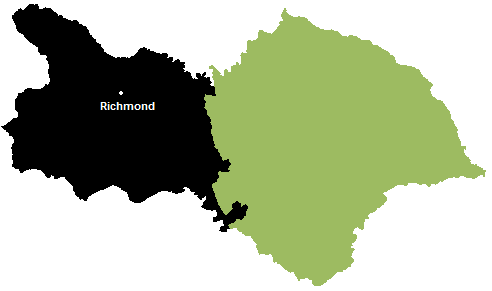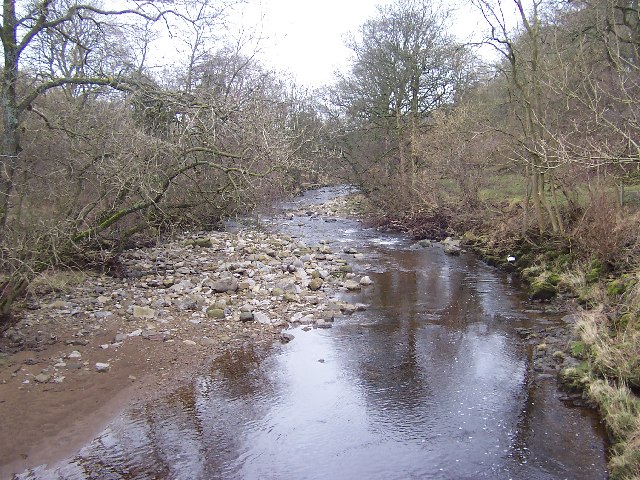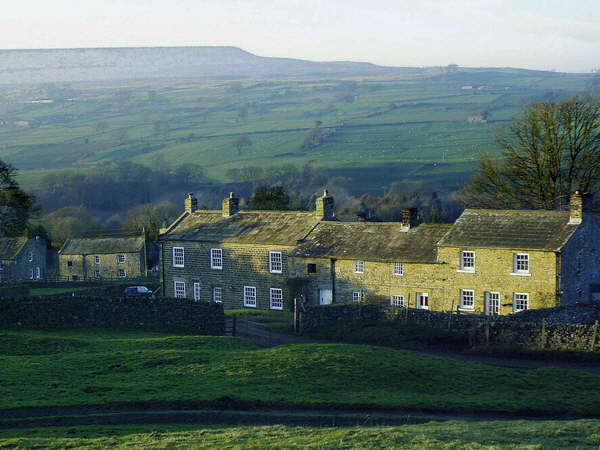|
West Scrafton
West Scrafton is a village and civil parish in Coverdale in the Yorkshire Dales, England. It is located south west of Leyburn. It falls within the Richmondshire district of North Yorkshire. The population was estimated at 70 in 2013. The village lies on the south bank of the River Cover. The parish extends south of the village, rising over West Scrafton Moor to the peak of Great Haw. West Scrafton has featured several times in the British television series '' All Creatures Great and Small'', in the episodes "A New Chapter" and "Alarms & Excursions". It is also where James Herriot, whose books were the inspiration for the series, holidayed with his wife, Joan. Scrafton was mentioned in the Domesday Book. The name is Old English, from ''scræf'' and ''tūn'', meaning "settlement at the hollow". By 1286 Scrafton had been divided into East Scrafton and West Scrafton. East Scrafton was the smaller place, and is now a hamlet in the neighbouring civil parish of Caldbergh with ... [...More Info...] [...Related Items...] OR: [Wikipedia] [Google] [Baidu] |
All Creatures Great And Small (1978 TV Series)
''All Creatures Great and Small'' is a British television series made by the BBC and based on the books of the British veterinary surgeon Alf Wight, who wrote under the pseudonym James Herriot. The title aired over seven series, totalling 90 episodes, from 1978 to 1990. A remake premiered in 2020. Set in the Yorkshire Dales and beginning in the mid-1930s, it stars Christopher Timothy as Herriot, Robert Hardy as Siegfried Farnon (based on Donald Sinclair), the proprietor of the Skeldale House surgery, and Peter Davison as Siegfried's "little brother", Tristan (based on Brian Sinclair). Herriot's wife, Helen (based on Joan Wight), was initially played by Carol Drinkwater and in the latter series by Lynda Bellingham. The series was produced throughout its run by Bill Sellars. In early 1977, the BBC tasked him with the creation of a television series from Herriot's first two novels, ''If Only They Could Talk'' (1970) and ''It Shouldn't Happen to a Vet'' (1972), using the title of ... [...More Info...] [...Related Items...] OR: [Wikipedia] [Google] [Baidu] |
Richmondshire
{{Infobox settlement , name = Richmondshire District , type = District , image_skyline = , imagesize = , image_caption = , image_blank_emblem= Richmondshire arms.png , blank_emblem_type = Coat of arms , image_map = Richmondshire UK locator map.svg , map_caption = Shown within North Yorkshire , mapsize = frameless , subdivision_type = Sovereign state , subdivision_name = United Kingdom , subdivision_type1 = Constituent country , subdivision_name1 = England , subdivision_type2 = Region , subdivision_name2 = Yorkshire and the Humber , subdivision_type3 = Administrative county , subdivision_name3 = North Yorkshire , seat_type = Admin. HQ , seat = Richmond , government_type = Richmondshire District Council , leader_title = Leadership: , leader_name = Alternative – Sec.31 , leader_title1 = Executive: , leader_name1 = {{English district contr ... [...More Info...] [...Related Items...] OR: [Wikipedia] [Google] [Baidu] |
East Scrafton
East Scrafton is a hamlet in the Yorkshire Dales in the Richmondshire district of North Yorkshire, England. It is about south-west of Leyburn. There is also a larger West Scrafton to the south. The name Scrafton comes from Old English Old English (, ), or Anglo-Saxon, is the earliest recorded form of the English language, spoken in England and southern and eastern Scotland in the early Middle Ages. It was brought to Great Britain by Anglo-Saxon settlement of Britain, Anglo ... and means ''farmstead near a hollow''. References External links Villages in North Yorkshire Coverdale (dale) {{NorthYorkshire-geo-stub ... [...More Info...] [...Related Items...] OR: [Wikipedia] [Google] [Baidu] |
Villages In North Yorkshire
A village is a clustered human settlement or community, larger than a hamlet but smaller than a town (although the word is often used to describe both hamlets and smaller towns), with a population typically ranging from a few hundred to a few thousand. Though villages are often located in rural areas, the term urban village is also applied to certain urban neighborhoods. Villages are normally permanent, with fixed dwellings; however, transient villages can occur. Further, the dwellings of a village are fairly close to one another, not scattered broadly over the landscape, as a dispersed settlement. In the past, villages were a usual form of community for societies that practice subsistence agriculture, and also for some non-agricultural societies. In Great Britain, a hamlet earned the right to be called a village when it built a church. [...More Info...] [...Related Items...] OR: [Wikipedia] [Google] [Baidu] |
Coal Mine
Coal mining is the process of extracting coal from the ground. Coal is valued for its energy content and since the 1880s has been widely used to generate electricity. Steel and cement industries use coal as a fuel for extraction of iron from iron ore and for cement production. In the United Kingdom and South Africa, a coal mine and its structures are a colliery, a coal mine is called a 'pit', and the above-ground structures are a 'pit head'. In Australia, "colliery" generally refers to an underground coal mine. Coal mining has had many developments in recent years, from the early days of men tunneling, digging and manually extracting the coal on carts to large open-cut and longwall mines. Mining at this scale requires the use of draglines, trucks, conveyors, hydraulic jacks and shearers. The coal mining industry has a long history of significant negative environmental impacts on local ecosystems, health impacts on local communities and workers, and contributes heavily to th ... [...More Info...] [...Related Items...] OR: [Wikipedia] [Google] [Baidu] |
North Riding Of Yorkshire
The North Riding of Yorkshire is a subdivision of Yorkshire, England, alongside York, the East Riding and West Riding. The riding's highest point is at Mickle Fell with 2,585 ft (788 metres). From the Restoration it was used as a lieutenancy area, having been previously part of the Yorkshire lieutenancy. Each riding was treated as a county for many purposes, such as quarter sessions. An administrative county, based on the riding, was created with a county council in 1889 under the Local Government Act 1888. In 1974 both the administrative county and the North Riding of Yorkshire lieutenancy were abolished, replaced in most of the riding by the non-metropolitan county and lieutenancy of North Yorkshire. History Archives from 1808 record that the "north-riding of York-shire" had once consisted of "fifty-one lordships" owned by Robert the Bruce. During the English Civil War, the North Riding predominantly supported the royalist cause, while other areas of York ... [...More Info...] [...Related Items...] OR: [Wikipedia] [Google] [Baidu] |
Coverham
Coverham is a village in Coverdale in the Yorkshire Dales in North Yorkshire, England. It lies west of the town of Middleham. History Coverham was mentioned in Domesday Book in 1086, when it was held by Count Alan of Brittany. It became the centre of a large parish in the Honour of Richmond in the North Riding of Yorkshire, which included the townships of Coverham with Agglethorpe, Caldbergh with East Scrafton, Carlton Highdale, Carlton Town, Melmerby and West Scrafton. All these townships became separate civil parishes in 1866. In the 2011 Census, Coverham village was included in the Parish of Melmerby, which had 213 people in it. In 2015, North Yorkshire County Council estimated that the population of Coverham with Agglethorpe was 90. Notable buildings The ruins of the Grade I listed Coverham Abbey are in the village; the site has no access to the public. Holy Trinity Church dates from the 13th century and became redundant in 1985. It is a Grade II* listed bu ... [...More Info...] [...Related Items...] OR: [Wikipedia] [Google] [Baidu] |
Township (England)
In England, a township (Latin: ''villa'') is a local division or district of a large parish containing a village or small town usually having its own church. A township may or may not be coterminous with a chapelry, manor, or any other minor area of local administration. The township is distinguished from the following: *Vill: traditionally, among legal historians, a ''vill'' referred to the tract of land of a rural community, whereas ''township'' was used when referring to the tax and legal administration of that community. *Chapelry: the 'parish' of a chapel (a church without full parochial functions). *Tithing: the basic unit of the medieval Frankpledge system. 'Township' is, however, sometimes used loosely for any of the above. History In many areas of England, the basic unit of civil administration was the parish, generally identical with the ecclesiastical parish. However, in some cases, particularly in Northern England, there was a lesser unit called a township, being a ... [...More Info...] [...Related Items...] OR: [Wikipedia] [Google] [Baidu] |
Coverham Abbey
Coverham Abbey, North Yorkshire, England, was a Premonstratensian monastery that was founded at Swainby in 1190 by Helewisia, daughter of the Chief Justiciar Ranulf de Glanville. It was refounded at Coverham in about 1212 by her son Ranulf fitzRalph, who had the body of his late mother reinterred in the chapter house at Coverham. There is some evidence that the during the first half of the 14th century the abbey and its holdings were attacked by the Scots, with the abbey itself being virtually destroyed. Later in that century there is a record of there being fifteen canons plus the abbot in residence. The abbey ruins are a Scheduled Ancient Monument and a Grade I listed building. Swainby Abbey Swainby Abbey () was a Premonstratensian abbey in North Yorkshire, England. It was founded in 1187 or 1188 by Helewise, the daughter of Ranulph de Glanville, Sheriff of Yorkshire and later Justiciar for King Henry II. She was the wife of Robert, Lord of Middleham. In 1195, Helewise was ... [...More Info...] [...Related Items...] OR: [Wikipedia] [Google] [Baidu] |
Vill
Vill is a term used in English history to describe the basic rural land unit, roughly comparable to that of a parish, manor, village or tithing. Medieval developments The vill was the smallest territorial and administrative unit—a geographical subdivision of the hundred and county—in Anglo-Saxon England. It served both a policing function through the tithing, and the economic function of organising common projects through the village moot. The term is the Anglicized form of the word , used in Latin documents to translate the Anglo-Saxon . The vill remained the basic rural unit after the Norman conquest—land units in the ''Domesday Book'' are frequently referred to as vills—and into the late medieval era. Whereas the manor was a unit of landholding, the vill was a territorial one—most vills did ''not'' tally physically with manor boundaries—and a public part of the royal administration. The vill had judicial and policing functions, including frankpledge, as well as resp ... [...More Info...] [...Related Items...] OR: [Wikipedia] [Google] [Baidu] |
Caldbergh With East Scrafton
Caldbergh with East Scrafton is a civil parish in the Richmondshire district of North Yorkshire, England. The parish includes the settlements of Caldbergh and East Scrafton East Scrafton is a hamlet in the Yorkshire Dales in the Richmondshire district of North Yorkshire, England. It is about south-west of Leyburn. There is also a larger West Scrafton to the south. The name Scrafton comes from Old English .... The population of the parish was estimated at 40 in 2013. In the 2011 Census the population of the parish was included with the parish of Melmerby, and not separately counted. References Coverdale (dale) Civil parishes in North Yorkshire {{richmondshire-geo-stub ... [...More Info...] [...Related Items...] OR: [Wikipedia] [Google] [Baidu] |
Victoria County History
The Victoria History of the Counties of England, commonly known as the Victoria County History or the VCH, is an English history project which began in 1899 with the aim of creating an encyclopaedic history of each of the historic counties of England, and was dedicated to Victoria of the United Kingdom, Queen Victoria. In 2012 the project was rededicated to Elizabeth II, Queen Elizabeth II in celebration of her Diamond Jubilee year. Since 1933 the project has been coordinated by the Institute of Historical Research in the University of London. History The history of the VCH falls into three main phases, defined by different funding regimes: an early phase, 1899–1914, when the project was conceived as a commercial enterprise, and progress was rapid; a second more desultory phase, 1914–1947, when relatively little progress was made; and the third phase beginning in 1947, when, under the auspices of the Institute of Historical Research, a high academic standard was set, and pr ... [...More Info...] [...Related Items...] OR: [Wikipedia] [Google] [Baidu] |







